| After a wonderful day observing giant Tortoises we had some free time for shopping in Port Ayoia and buying postcards. The cards were cheap but the stamps were $1 each. We didn't send many cards. The group then gathered for a group dinner. Our hearts and minds full of memories, at sundown we headed for the harbor for our water taxi ride to the Millennium. Last night, November 11th, in Minnesota, the sun went down about 4:30 p.m. Because I depend upon the sun for my photographs I was concerned about the length of the days on this trip - especially since I knew we would be south of the equator. I soon learned that on the equator the length of daylight is the same all year - 12 hours, give or take 30 minutes depending upon which season you are in. We boarded our ship and headed out to sea for our next destination. Marie described our night as follows; |
Really could have used a net. Windows opened by themselves, Closet doors, stuff leapt off shelves; Like poltergeist activity, My bedding rolled away from me. Through the night got little sleep, But had a morning date to keep... |
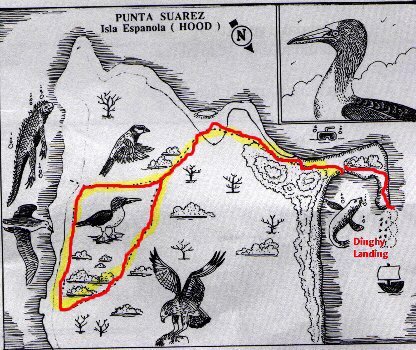 |
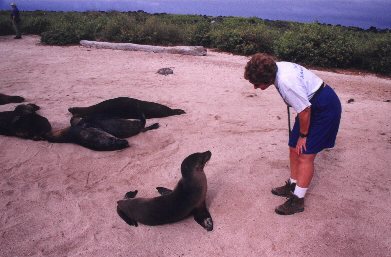 |
We landed at Punta Suarez on Espanola one of the most attractive sites on the Galapagos and number two on my list of favorites. Upon landing we were greeted by a herd of sea lions. Fran tested her language arts talking to a sea lion pup but I don't think she learned any secrets of the island. |
| Prior to our departure for the Galapagos it was my intense desire to see a marine iguana. I had heard so much about them and seen so many nature stories on television that I was confident they would be the highlight of my visit. I was surprised, but it was the blue-footed boobie which really captured my heart and on Espanola we were overwhelmed by them. | 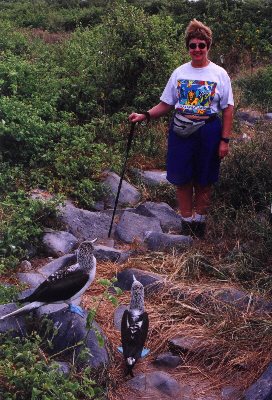 |
Espanola is their nesting ground and as I mentioned before, they mate for life. They were called "boobies" by the early Spanish sailors because they had no fear of anything, nest on the ground, and were easily captured by the sailors. The name comes from the Spanish wood "bobo" meaning "dunce." They had no enemies because they are gosh awful tasting and thus in spite of their size they didn't add anything to the food supply. As we walked along the established path the boobies would stand their ground and look at us with their yellow eyes wide open. They wouldn't budge and never flinched requiring us to walk around them. |
| We got a real treat because we found several nests with eggs in them. Both male and female care for the eggs and from time to time they move the egg over to make sure it is being warmed evenly. You will note that the egg is blue like their feet. Roberto, our resident Dr. Doolittle, explained how we could tell the difference between a male and female. The male boobie whistles and the female clucks like a chicken. |
 |
| We are told they have a unique courtship dance which we did not see. On land they waddle clumsily like ducks but in the air they are so graceful and look like an arrow when they tuck in their wings and dive into the sea for fish from heights of 65 feet. Yes, the blue-footed boobie captured my heart. |
| As you may have suspected, not all Boobies are alike. As enthralled as I was with the Blue-footed Booby, the Booby does come in different sizes and colors. This is the "Masked Booby". It is much larger and more aloof - you can't get close to this bird. It is a beautiful white bird with "lovely stark black trim"; like a formal gown. | 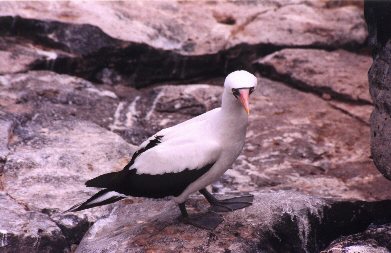 |
With the black mask around its eyes it looks like it is going to a formal masked ball in Venice. Unfortunately we did not see the Red-footed Booby and you will just have to imagine what it looks like. I guess this is another reason to return to the Galapagos. |
| Espanola is the only nesting place in the world for the yellow billed Waved Albatross. The 10,000 to 12,000 pairs of albatrosses on Espanola are all the individuals of this species that exist on the planet. Like the Blue-footed Booby they have a spectacular mating ritual which consists of dancing about and "fencing" with their beaks - literally, standing face to face and clicking their beaks together at a great rate. Like the Booby, they nest on the ground. They are large birds, up to one meter high, and do not take off from land - they clumsily wobble to the edge of the cliff and launch themselves against the wind to be transformed into a most gracious flying creature. | 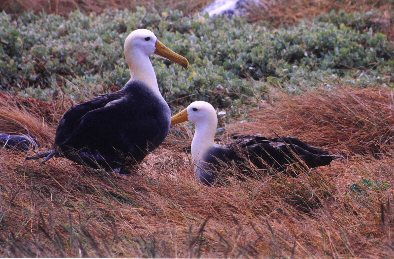 |
| Espanola is the home of the "giant lava lizard". This one must be at least 6 inches long from nose to end of tail. On an island where food is in short supply, it doesn't take much to be called a "giant". | 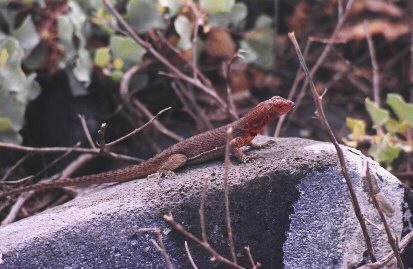 |
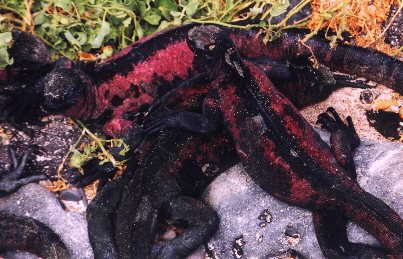 |
Espanola is also the home of the unique species of red marine iguana. Like the black marine iguana you have seen before this one is red because it feeds on the red algae which grows under water on the rocks. Feeding habits can make all the difference in the world here. Remember? The yellow land iguana got its color because it fed on the yellow petals of the Galapagos cotton tree. |
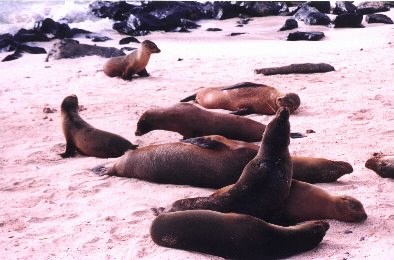 After seeing so many exotic birds and reptiles our heads were spinning. Every bird seemed to have blue feet. How was this possible? We made our way to the shore and were greeted once again by a herd of barking sea lions. |
 "Get in the dinghy," commanded Roberto with military authority, "Women and children first." It sure doesn't look like any of these people are in severe distress. Roberto stands at the stern near the motor while the Captain of the Millennium is on the right at the bow. This was a great morning but disaster struck - our rubber dinghy sprung a leak and began to lose air. We all made it back to the ship but it was two days before the hole could be totally repaired. |
| We visited Espanola on Tuesday and our week was almost over. On Thursday morning we leave Baltra for the mainland. So many places to go, and so much to see, and so far between the islands. Choices have to be made, and some things can't be seen. Look at my map of the Galapagos and you will find the small island of Espanola located at the southern most point of the archipelago. No matter where we go it is going to be a long sail home. I had wanted to see the famed Post Office Bay located to the west on Isla Floreana. |
 (photo from Insight Guides Travel book on Ecuador) |
| Here you see the white barrel with blue stipes which serves as the post box where whalers used to leave mail in the 18th century. Although the box has been replaced several times it is still in use. It was the custom for whalers to look through the mail and take anything addressed to their destination, or home town, put a local stamp on it when they arrived in port and send it on its way. |
| Instead the Millennium headed northeast for San Cristobal and the sleepy town of Puerto Baquerizo Moreno to visit the Interpretation Center opened by the Galapagos National Park. This is Roberto's home town and it was a good choice. The Interpretation Center was very nicely done consisting of several buildings with raised wooden paths between buildings. In this way the Center was able to point out the various flora typical of the Galapagos. In the buildings were historical photographs and models of whaling ships which depicted, among other things, how tortoises were stacked in the hold and a re-creation of the famed whalers post office. Unfortunately I didn't have my camera with me and thus I have no photographs. | 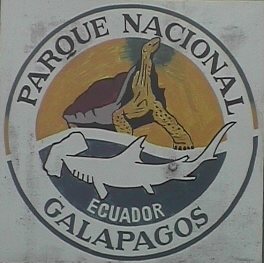 |
The Millennium stayed in the calm waters of Puerto Baquerizo Moreno until 3:00 a.m. at which time the crew weighed anchor and, while we slept, headed out to sea for Santa Fe Island. |
If you have any questions about what you are seeing, or want some further information, feel free to
send me a note. 
If you are looking for a good tour book I recommend Ecuador & Galapagos published by Insight Guides. Although it covers a lot of Ecuador it has the greatest explaination and photographs of the Galapagos Islands. I bought my copy at Barnes and Nobel Bookseller after I returned.

Since October 19, 2002, you are visitor: